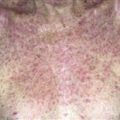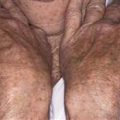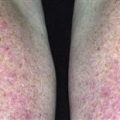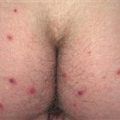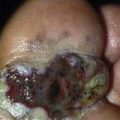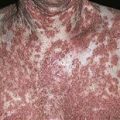27
Angioedema
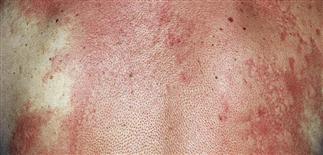
This patient had hives and angioedema. This is an extensive case with very large plaques with deep swelling. The major complaint was discomfort and some itching.
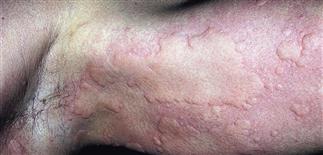
The plaques of angioedema are uniform, tense, non-pitting, and non-erythematous. The borders may be well defined. These plaques lack the faint white or red halo found with hives.
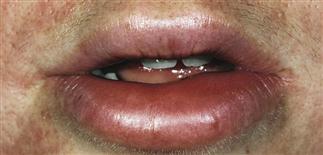
Swelling of the lips is a classic sign of angioedema. Swelling may be massive and the only manifestation of the disease.
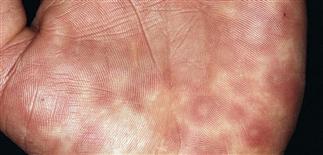
Swelling of the palms is another highly characteristic sign of angioedema. Circular lesions may resemble erythema multiforme. Erythema multiforme is not associated with swelling found in angioedema.
DESCRIPTION
Non-pitting, well-defined area of edema caused by increased vascular permeability in subcutaneous tissue of skin, mucosa. Airway obstruction with laryngeal edema can be fatal. This most often occurs in hereditary angioedema and angiotensin-converting enzyme (ACE) inhibitor-associated angioedema. Colicky abdominal pain, nausea, vomiting, diarrhea are the result of intestinal wall edema.
Several causes. • Idiopathic (most common). • Immunologic IgE allergic reaction (foods, drugs, stinging insect venom, pollen); hives often present. • Non-immunologic medication-induced (e.g. ACE inhibitors). • Hereditary (type 1, type 2). • Acquired type 1, type 2 very rare.
Hereditary angioedema types 1 and 2 are autosomal dominant, associated with recurrent, self-limited, chronic attacks. Inherited deficiency of C1-esterase inhibitor (C1-INH) in both types. • Type 1 (80–85% of cases): serum levels of C1-INH low. • Type 2: serum levels of C1-INH normal but C1-INH functional assay low.
C4 (screening test during attacks) low during attacks in both types. C1q normal in hereditary angioedema, low in patients with very rare acquired types 1 and 2.
HISTORY
• Hives, angioedema common. • Inquire about drugs (especially ACE inhibitors), aspirin, non-steroidal anti-inflammatory drugs, foods, insect stings, and family history. • Angioedema may be painful; pruritus minimal.
PHYSICAL FINDINGS
• Well-circumscribed, non-pitting edema of the head, face, lips, tongue and larynx. Palms, soles can be affected. Reaction similar to that of hives, but significant swelling occurs in subcutaneous tissues of skin and mucosa. • Clinical appearance tends to be more dramatic than hives, can cause disfigurement to point where patient is unrecognizable.
TREATMENT
• Most common forms of angioedema: idiopathic or allergic. • Initial goal of therapy: airway management. • Treat acute, severe attacks with adrenaline (epinephrine). • Treat with hydroxyzine 10–50 mg every 4–6 h. Liquid hydroxyzine 10 mg/5 cc works faster. Doses as high as 100 mg every 4 h may be used. Many patients adapt to sedation after a few days. • Non-sedating H1 blockers do not work as well but useful for daytime hours and milder cases. Loratadine (Claritin) 10 mg q.d. is non-prescription. Desloratadine (Clarinex) 5 mg q.d., cetirizine (Zyrtec) 5 mg or 10 mg q.d., and fexofenadine (Allegra) 60 mg b.i.d. or 180 mg q.d. • Prednisone (e.g. 60 mg for 2 days, 40 mg for 5 days, then 20 mg for 7 days) may be effective, is used when patients not responding to antihistamines. • Acute attacks of hereditary and acquired angioedema treated with C1-INH concentrate or fresh frozen plasma. • Danazol and stanozol for long-term prophylaxis.

